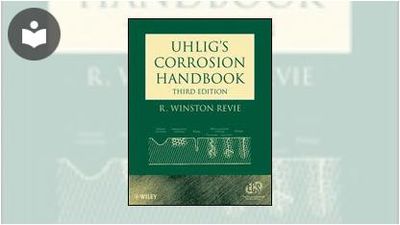Uhlig's Corrosion Handbook, Third Edition
- 38h 37m
- R. Winston Revie (ed)
- John Wiley & Sons (US)
- 2011
This book serves as a reference for engineers, scientists, and students concerned with the use of materials in applications where reliability and resistance to corrosion are important. It updates the coverage of its predecessor, including coverage of: corrosion rates of steel in major river systems and atmospheric corrosion rates, the corrosion behavior of materials such as weathering steels and newer stainless alloys, and the corrosion behavior and engineering approaches to corrosion control for nonmetallic materials.
New chapters include: high-temperature oxidation of metals and alloys, nanomaterials, and dental materials, anodic protection. Also featured are chapters dealing with standards for corrosion testing, microbiological corrosion, and electrochemical noise.
About the Author
R. Winston Revie has had a career of more than thirty years at the CANMET Materials Technology Laboratory in Ottawa, Canada, where he is a Senior Research Scientist and Program Manager. Currently, he is President of the NACE Foundation of Canada, a registered educational charity. He is also past director of the Northern Area of NACE International; a past chairman of the ASM Canada Council and of the Electrochemical Society Canadian Section; and a past president of the Metallurgical Society of the Canadian Institute of Mining, Metallurgy and Petroleum. Dr. Revie coauthored the third and fourth editions of Corrosion and Corrosion Control, a widely used textbook, and was the editor of the second edition of Uhlig's Corrosion Handbook. Dr. Revie is a Fellow of NACE International, ASM International, and the Canadian Institute of Mining, Metallurgy and Petroleum.
In this Book
-
Corrosion Failure Analysis with Case Histories
-
Cost of Metallic Corrosion
-
Economics of Corrosion
-
Lifetime Prediction of Materials in Environments
-
Estimating the Risk of Pipeline Failure Due to Corrosion
-
Designing to Prevent Corrosion
-
Simplified Procedure for Constructing Pourbaix Diagrams
-
Pourbaix Diagrams for Multielement Systems
-
Computation of Pourbaix Diagrams at Elevated Temperature
-
Galvanic Corrosion
-
Dealloying
-
Passivity
-
Localized Corrosion of Passive Metals
-
Stress Corrosion Cracking
-
Hydrogen-Induced Cracking and Sulfide Stress Cracking
-
Corrosion Fatigue
-
Flow Effects on Corrosion
-
Erosion—Corrosion in Single- and Multiphase Flow
-
Carbon Dioxide Corrosion of Mild Steel
-
High-Temperature Oxidation
-
Thermochemical Evaluation of Corrosion Product Stabilities for Alloys in Gases at High Temperature
-
A Procedure to Compute Equilibrium Gas-Phase Speciation for Use with Predominance Diagrams
-
Atmospheric Corrosion
-
Atmospheric Corrosion in Cold Regions
-
Corrosion by Soils
-
Microbial Degradation of Materials: General Processes
-
Corrosion Probability and Statistical Evaluation of Corrosion Data
-
Corrosion of Refractories and Ceramics
-
Corrosion of Glass
-
Microbiological Degradation of Polymeric Materials
-
Durability of Concrete
-
Microbiological Corrosion of Concrete
-
Microbial Degradation of Wood
-
Use of Chemicals to Prevent Degradation of Wood
-
Metal—Matrix Composites
-
Environmental Degradation of Engineered Barrier Materials in Nuclear Waste Repositories
-
Corrosion Behavior of Electrodeposited Nanocrystals
-
Corrosion of Shape Memory and Superelastic Alloys
-
Microbiological Corrosion of Metallic Materials
-
Electronic Materials, Components, and Devices
-
Corrosion of Electronics: Lead-Free Initiatives
-
Metastable Alloys
-
Carbon Steel—Atmospheric Corrosion
-
Carbon Steel—Corrosion in Freshwaters
-
Carbon Steel—Corrosion by Seawater
-
Carbon Steel—Corrosion by Soils
-
Localized Corrosion of Iron and Steel
-
Weathering Steel
-
Corrosion of Steel in Concrete
-
Ethanol Stress Corrosion Cracking of Carbon Steels
-
Austenitic and Ferritic Stainless Steels
-
Duplex Stainless Steels
-
Martensitic Stainless Steels
-
Aluminum and Aluminum Alloys
-
Cobalt Alloys
-
Copper and Copper Alloys
-
Lead and Lead Alloys
-
Magnesium and Magnesium Alloys
-
Nickel and Nickel Alloys
-
Tin and Tinplate
-
Titanium and Titanium Alloys
-
Zinc
-
Zirconium Alloy Corrosion
-
Controlling Flow Effects on Corrosion
-
Erosion—Corrosion: Recognition and Control
-
Using Plastics, Elastomers, and Composites for Corrosion Control
-
Corrosion Control of Steel By Organic Coatings
-
Selection and Use of Coatings for Underground or Submersion Service
-
Engineering of Cathodic Protection Systems
-
Stray-Current Analysis
-
Corrosion Inhibitors
-
Computer Technology for Corrosion Assessment and Control
-
Principles of Accelerated Corrosion Testing
-
High-Temperature Oxidation—Testing and Evaluation
-
Testing for Flow Effects on Corrosion
-
Accelerated Testing of Electronics to Simulate Long-Term Worldwide Environments
-
Testing for Environmentally Assisted Cracking
-
Test Methods for Wet H2S Cracking
-
Atmospheric Corrosion Testings
-
Galvanic Corrosion Testing
-
Testing of Aluminum, Magnesium, and Their Alloys
-
Testing of Polymeric Materials for Corrosion Control
-
Corrosion Testing of Refractories and Ceramics
-
Evaluation and Selection of Corrosion Inhibitors
-
Practical Corrosion Prediction Using Electrochemical Techniques
-
Electrochemical Noise
-
Corrosion Monitoring
-
Diagnosing, Measuring, and Monitoring Microbiologically Influenced Corrosion
-
Glossary of Selected Terms Used in Corrosion Science and Engineering



